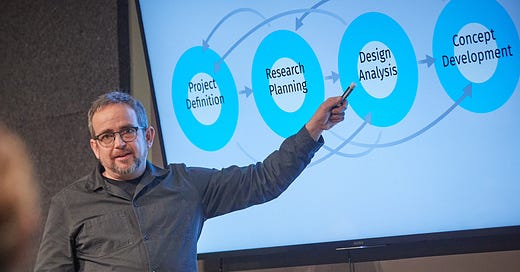I sincerely hope the lessons coming to this Substack make your work more difficult. I want you to push beyond what is comfortable and familiar in your work. I hope these insights provide a foundation of confidence as you insert yourself into situations where no one thought to ask for your help. I hope these frameworks, tools, and methods enable you to bring clarity and insight to ever bigger, messier, stickier, and more ambiguous challenges. And I hope they stoke your bravery—to stick your hands into the muck and sculpt it into what you believe it should be. And I hope you have fun doing it.
Throughout my journey of studying, practicing, and teaching design I have witnessed many changes in the practice. We use different tools now, tackle more types of projects, we have different titles (so many different titles) and, in many cases, more influence.
No one can predict the change coming in the practice of design, but I expect it will be even more dramatic than what I have witnessed. As a teacher of design, this weighs heavily–how do I prepare you for such unknown terrain?
In this series of essays, I will share and reflect on the tools and frameworks I use in my work and teach in the Master's program in Interaction Design at California College of the Arts. I’m grateful for the rich experiences I’ve had—both in school and throughout my career—that exposed me to these ideas, and I’m thrilled to pass them on. These are lessons that have proven durable and valuable for me, and I hope they will continue to be so through whatever change is on our horizon.
These essays will cover a range of themes, including approaches to design decision-making, effective ways to frame both small and large design problems, exploration and navigation of solution spaces, and techniques for telling compelling, persuasive stories about the futures you want to create.
These are not meant as unequivocal claims about how things are or how they should be. It’s not a manifesto. It’s what I know. Design is a broad discipline and there are many approaches that can lead to outstanding results. I hope you find something in these lessons that you can add to your toolkit.
I recognize that many of these ideas are not entirely new. Where I’m aware of the work that came before me, I’ll make sure to reference it. Still, I’m certain that some influences have worked their way into my thinking without explicit credit, and for that, my apologies. I welcome any corrections or contributions that help acknowledge the work of others more fully.
Applying these principles has brought a sense of excitement, exploration, and discovery to my work. I hope to help you find your own path as you help shape the future of design—and the future of the world.
Here’s to enjoying the challenging task of creating the future we want to see!
Matthew Beebe
CREDIT: This “letter to students of design” and my opening sentence are directly influenced by my favorite design writer of all time, Bob Gill. I highly recommend every single word of each of his books. This book specifically taught me everything I need to know about design and probably renders my entire substack endeavor completely unnecessary.
Subscribe anyway please.






